Study of the Utilisation of Almond Residues for Low-Cost Panels
Abstract
1. Introduction
2. Materials and Methods
2.1. Materials
2.2. Methods
3. Results and Discussion
3.1. Density
3.2. Thickness Swelling (TS) and Water Absorption (WA) after 2 h and 24 h Water Immersion
3.3. Modulus of Rupture (MOR) and Modulus of Elasticity (MOE)
3.4. Internal Bonding Strength (IB)
3.5. Result of the Chemical Analysis
4. Conclusions
Author Contributions
Funding
Acknowledgments
Conflicts of Interest
References
- Chen, P.; Cheng, Y.; Deng, S.; Lin, X.; Huang, G.; Ruan, R. Utilization of almond residues. Int. J. Agric. Biol. 2010, 3, 1–18. [Google Scholar]
- Offeman, R.D.; Dao, G.T.; Holtman, K.M.; Orts, W.J. Leaching behavior of water-soluble carbohydrates from almond hulls. Ind. Crop. Prod. 2015, 65, 488–495. [Google Scholar] [CrossRef]
- Sequeira, R.M.; Lew, R.B. The carbohydrate composition of almond hulls. J. Agric. Food Chem. 1970, 18, 950–951. [Google Scholar] [PubMed]
- Amico, V.; Barresi, V.; Condorelli, D.; Spatafora, C.; Tringali, C. Antiproliferative Terpenoids from Almond Hulls (Prunus dulcis): Identification and Structure—Activity Relationships. J. Agric. Food Chem. 2006, 54, 810–814. [Google Scholar] [CrossRef] [PubMed]
- Takeoka, G.; Dao, L.; Teranishi, R.; Wong, R.; Flessa, S.; Harden, L.; Edwards, R. Identification of three triterpenoids in almond hulls. J. Agric. Food Chem. 2000, 48, 3437–3439. [Google Scholar] [CrossRef]
- Sang, S.; Lapsley, K.; Rosen, R.T.; Ho, C.T. New prenylated benzoic acid and other constituents from almond hulls (Prunus amygdalus Batsch). J. Agric. Food Chem. 2002, 50, 607–609. [Google Scholar] [CrossRef]
- Takeoka, G.R.; Dao, L.T. Antioxidant constituents of almond [Prunus dulcis (Mill.) DA Webb] hulls. J. Agric. Food Chem. 2003, 51, 496–501. [Google Scholar] [CrossRef]
- Pinelo, M.; Rubilar, M.; Sineiro, J.; Núñez, M.J. Extraction of antioxidant phenolics from almond hulls (Prunus amygdalus L.) and pine sawdust (Pinus pinaster). Food Chem. 2004, 85, 267–273. [Google Scholar] [CrossRef]
- Wijeratne, S.S.; Abou-Zaid, M.M.; Shahidi, F. Antioxidant Polyphenols in Almond and Its Coproducts. J. Agric. Food Chem. 2005, 54, 312–318. [Google Scholar] [CrossRef]
- Rubilar, M.; Pinelo, M.; Shene, C.; Sineiro, J.; Nuñez, M.J. Separation and HPLC-MS identification of phenolic antioxidants from agricultural residues: Almond hulls and grape pomace. J. Agric. Food Chem. 2007, 55, 10101–10109. [Google Scholar] [CrossRef]
- Sfahlan, A.J.; Mahmoodzadeh, A.; Hasanzadeh, A.; Heidari, R.; Jamei, R. Antioxidants and antiradicals in almond hull and shell (Amygdalus communis L.) as a function of genotype. Food Chem. 2009, 115, 529–533. [Google Scholar] [CrossRef]
- Demirbas, A.; Pehlivan, E.; Altun, T. Potential evolution of Turkish agricultural residues as bio-gas, bio-char and bio-oil sources. Int. J. Hydrog. Energy. 2006, 31, 613–620. [Google Scholar] [CrossRef]
- Holtman, K.M.; Offeman, R.D.; Franqui-Villanueva, D.; Bayati, A.K.; Orts, W.J. Countercurrent extraction of soluble sugars from almond hulls and assessment of the bioenergy potential. J. Agric. Food Chem. 2015, 63, 2490–2498. [Google Scholar] [CrossRef] [PubMed]
- Aktas, T.; Thy, P.; Williams, R.B.; McCaffrey, Z.; Khatami, R.; Jenkins, B.M. Characterization of almond processing residues from the Central Valley of California for thermal conversion. Fuel Process. Technol. 2015, 140, 132–147. [Google Scholar] [CrossRef]
- Ioannidou, O.; Zabaniotou, A. Agricultural residues as precursors for activated carbon production—A review. Renew. Sust. Energ. Rev. 2007, 11, 1966–2005. [Google Scholar] [CrossRef]
- Reddad, Z.; Gerente, C.; Andres, Y.; Le Cloirec, P. Adsorption of several metal ions onto a low-cost biosorbent: Kinetic and equilibrium studies. Environ. Sci. Technol. 2002, 36, 2067–2073. [Google Scholar] [CrossRef] [PubMed]
- Ahmadpour, A.; Tahmasbi, M.; Bastami, T.R.; Besharati, J.A. Rapid removal of cobalt ion from aqueous solutions by almond green hull. J. Hazard. Mater. 2009, 166, 925–930. [Google Scholar] [CrossRef]
- Adegoke, K.A.; Bello, O.S. Dye sequestration using agricultural wastes as adsorbents. Water Resour. Ind. 2015, 12, 8–24. [Google Scholar] [CrossRef]
- Alibes, X.; Maestre, M.R.; Muñoz, F.; Combellas, J.; Rodriguez, J. Nutritive value of almond hulls for sheep. Anim. Feed Sci. Technol. 1983, 8, 63–67. [Google Scholar] [CrossRef]
- Aguilar, A.A.; Smith, N.E.; Baldwin, R.L. Nutritional value of almond hulls for dairy cows. J. Dairy Sci. 1984, 67, 97–103. [Google Scholar] [CrossRef]
- Aderibigbe, A.O.; Tor-Agbidye, Y.; Cheeke, P.R.; Patton, N.M. Evaluation of almond hulls as a feedstuff for rabbits. J. Appl. Rabbit Res. 1990, 13, 110–113. [Google Scholar]
- Jahanban-Esfahlan, A.; Jamei, R.; Jahanban-Esfahlan, R. The importance of almond (Prunus amygdalus L.) and its by-products. Food Chem. 2010, 120, 349–360. [Google Scholar] [CrossRef]
- Yalchi, T.; Kargar, S. Chemical composition and in situ ruminal degradability of dry matter and neutral detergent fiber from almond hulls. J. Food Agric. Environ. 2010, 8, 781–784. [Google Scholar]
- Jafari, S.; Alizadeh, A.; Imni, A.; Meng, G.Y.; Rajion, M.A.; Ebrahimi, M. In situ degradation of almond (Prunus dulcis L.) hulls, a potential feed material for ruminants. Turk. J. Vet. Anim. Sci. 2015, 39, 676–681. [Google Scholar] [CrossRef]
- Gürü, M.; Tekeli, S.; Bilici, I. Manufacturing of urea–formaldehyde-based composite particleboard from almond shell. Mater. Des. 2006, 27, 1148–1151. [Google Scholar] [CrossRef]
- Pirayesh, H.; Khazaeian, A. Using almond (Prunus amygdalus L.) shell as a bio-waste resource in wood based composite. Compos. Pt. B Eng. 2012, 43, 1475–1479. [Google Scholar] [CrossRef]
- Chaudhary, A.K.; Gope, P.C.; Singh, V.K. Effect of almond shell particles on tensile property of particleboard. J. Mater. Environ. Sci. 2013, 4, 109–112. [Google Scholar]
- Sabarinathan, P.; Rajkumar, K.; Gnanavelbabu, A. Mechanical properties of almond shell-sugarcane leaves hybrid epoxy polymer composite. Appl. Mech. Mater. 2016, 852, 43–48. [Google Scholar] [CrossRef]
- Quiles-Carrillo, L.; Montanes, N.; Sammon, C.; Balart, R.; Torres-Giner, S. Compatibilization of highly sustainable polylactide/almond shell flour composites by reactive extrusion with maleinized linseed oil. Ind. Crop. Prod. 2018, 111, 878–888. [Google Scholar] [CrossRef]
- Ferrandez-Villena, M.; Ferrandez-Garcia, C.E.; Andreu-Rodriguez, J.; Ferrandez-Garcia, M.T.; Garcia-Ortuño, T. Effect of pressing conditions on physical and mechanical properties of binderless boards made from almond hulls (Prunus dulcis (Mill.) DA Webb). Actual Tasks on Agricultural Engineering. In Proceedings of the 41 International Symposium on Agricultural Engineering, University of Zagreb Faculty of Agriculture, Opatija, Croatia, 19–22 February 2013; pp. 392–397. [Google Scholar]
- Amirou, S.; Zerizer, A.; Pizzi, A.; Haddadou, I.; Zhou, X. Particleboards production from date palm biomass. Eur. J. Wood Wood Prod. 2013, 71, 717–723. [Google Scholar] [CrossRef]
- Saadaoui, N.; Rouilly, A.; Fares, K.; Rigal, L. Characterization of date palm lignocellulosic by-products and self-bonded composite materials obtained thereof. Mater. Des. 2013, 50, 302–308. [Google Scholar] [CrossRef]
- Hegazy, S.; Ahmed, K.; Hiziroglu, S. Oriented strand board production from water-treated date palm fronds. BioResources 2014, 10, 448–456. [Google Scholar] [CrossRef]
- Laemsak, N.; Okuma, M. Development of boards made from oil palm frond II: Properties of binderless boards from steam-exploded fibers of oil palm frond. J. Wood Sci. 2000, 46, 322–326. [Google Scholar] [CrossRef]
- Hashim, R.; Nadhari, W.N.A.; Sulaiman, O.; Kawamura, F.; Hiziroglu, S.; Sato, M.; Sugimoto, T.; Seng, T.G.; Tanaka, R. Characterization of raw materials and manufactured binderless particleboard from oil palm biomass. Mater. Des. 2011, 32, 246–252. [Google Scholar] [CrossRef]
- Boon, J.G.; Hashim, R.; Sulaiman, O.; Hiziroglu, S.; Sugimoto, T.; Sato, M. Influence of processing parameters on some properties of oil palm trunk binderless particleboard. Eur. J. Wood Wood Prod. 2013, 71, 583–589. [Google Scholar] [CrossRef]
- Lammaming, J.; Sulaiman, O.; Sugimoto, T.; Hashim, R.; Said, N.; Sato, M. Influence of chemical components of oil palm on properties of binderless particleboard. BioResources 2013, 8, 3358–3371. [Google Scholar] [CrossRef]
- Jumhuri, N.; Hashim, R.; Sulaiman, O.; Aidawati, W.N.; Salleh, K.M.; Saharudin, N.I.; Razali, M.Z. Effect of treated particles on the properties of particleboard made from oil palm trunk. Mater. Des. 2014, 64, 769–774. [Google Scholar] [CrossRef]
- Henao, E.M.; Quintana, G.C.; Ogunsile, B.O. Development of binderless fiberboards from steam-exploded and oxidized oil palm wastes. BioResources 2014, 9, 2922–2936. [Google Scholar]
- Ferrández-García, A.; Ferrández-Villena, M.; Ferrández-García, C.E.; García-Ortuño, T.; Ferrández-García, M.T. Potential Use of Phoenix canariensis Biomass in Binderless Particleboards at Low Temperature and Pressure. BioResources 2017, 12, 6698–6712. [Google Scholar] [CrossRef]
- Kurokochi, Y.; Sato, M. Effect of surface structure, wax and silica on the properties of binderless board made from rice straw. Ind. Crop. Prod. 2015, 77, 949–953. [Google Scholar] [CrossRef]
- Ferrandez-Garcia, C.C.; Garcia-Ortuño, T.; Ferrandez-Garcia, M.T.; Ferrandez-Villena, M.; García, C.E.F. Fire-resistance, physical, and mechanical characterization of binderless rice straw particleboards. BioResources 2017, 12, 8539–8549. [Google Scholar]
- Xu, J.; Sugawara, R.; Widyorini, R.; Han, G.; Kawai, S. Manufacture and properties of low-density binderless particleboard from kenaf core. J. Wood Sci. 2004, 50, 62–67. [Google Scholar] [CrossRef]
- Widyorini, R.; Xu, J.; Watanabe, T.; Kawai, S. Chemical changes in steam-pressed kenaf core binderless particleboard. J. Wood Sci. 2005, 51, 26–32. [Google Scholar] [CrossRef]
- Nonaka, S.; Umemura, K.; Kawai, S. Characterization of bagasse binderless particleboard manufactured in high-temperature range. J. Wood Sci. 2013, 59, 50–56. [Google Scholar] [CrossRef]
- Van Dam, J.E.; van den Oever, M.J.; Keijsers, E.R. Production process for high density high performance binderless boards from whole coconut husk. Ind. Crop. Prod. 2004, 20, 97–101. [Google Scholar] [CrossRef]
- Widyorini, R.; Yudha, A.P.; Prayitno, T.A. Some of the properties of binderless particleboard manufactured from bamboo. Wood Res. J. 2011, 2, 89–93. [Google Scholar]
- Khazaeian, A.; Ashori, A.; Dizaj, M.Y. Suitability of sorghum stalk fibers for production of particleboard. Carbohydr. Polym. 2015, 120, 15–21. [Google Scholar] [CrossRef]
- Ferrández-Garcia, M.T.; Ferrández-García, C.E.; Andreu-Rodriguez, J.; Ferrández-Villena, M.; García-Ortuño, T. The suitability of utilising cotton stalk for low cost binderless panels. Actual Tasks on Agricultural Engineering. In Proceedings of the 41 International Symposium on Agricultural Engineering, University of Zagreb Faculty of Agriculture, Opatija, Croatia, 19–22 February 2013; pp. 388–392. [Google Scholar]
- EN 309. Particleboards. Definitions and Classification; European Committee for Standardization: Brussels, Belgium, 2005. [Google Scholar]
- EN 323. Wood-Based Panels. Determination of Density; European Committee for Standardization: Brussels, Belgium, 1993. [Google Scholar]
- EN 317. Particleboards and Fiberboards. Determination of Swelling in Thickness after Immersion in Water; European Committee for Standardization: Brussels, Belgium, 1993. [Google Scholar]
- EN 319. Particleboards and Fiberboards. Determination of Tensile Strength Perpendicular to the Plane of de Board; European Committee for Standardization: Brussels, Belgium, 1993. [Google Scholar]
- EN 310. Wood-Based Panels. Determination of Modulus of Elasticity in Bending and of Bending Strength; European Committee for Standardization: Brussels, Belgium, 1993. [Google Scholar]
- EN 312. Particleboards–Specifications; European Committee for Standardization: Brussels, Belgium, 2010. [Google Scholar]
- Sluiter, A.; Hames, B.; Ruiz, R.; Scarlata, C.; Sluiter, J.; Templeton, D.; Crocker, D. Determination of structural carbohydrates and lignin in biomass. Lab. Anal. Proced. 2012, 1617, 1–16. [Google Scholar]
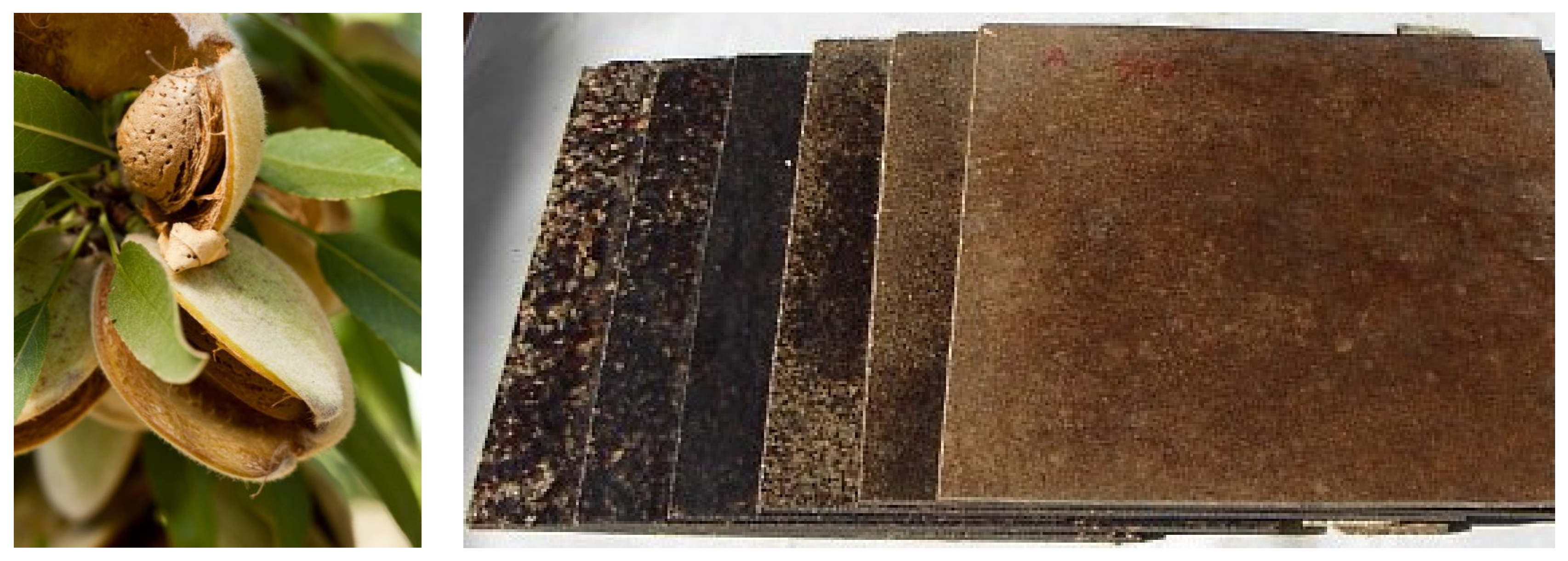
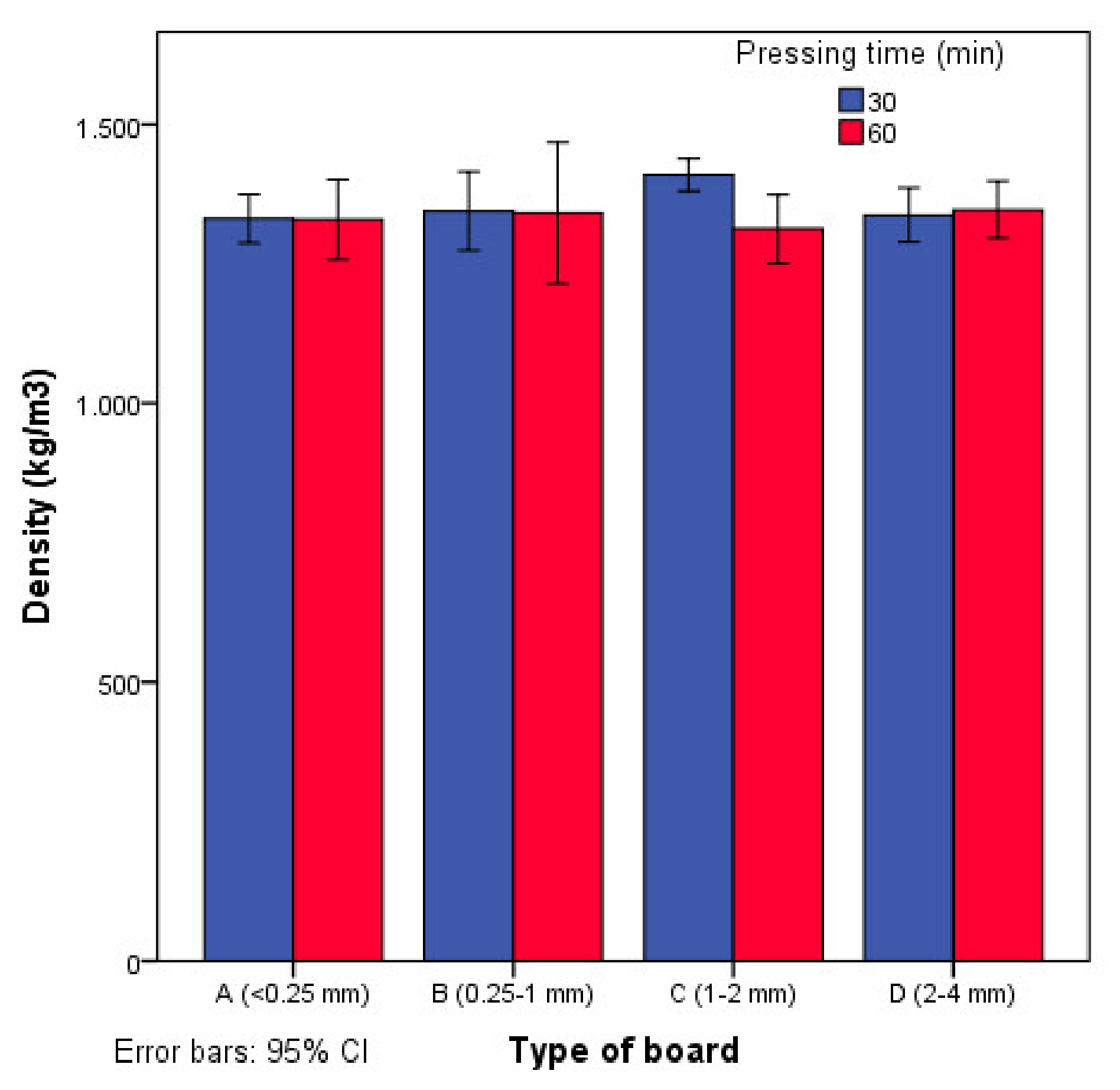
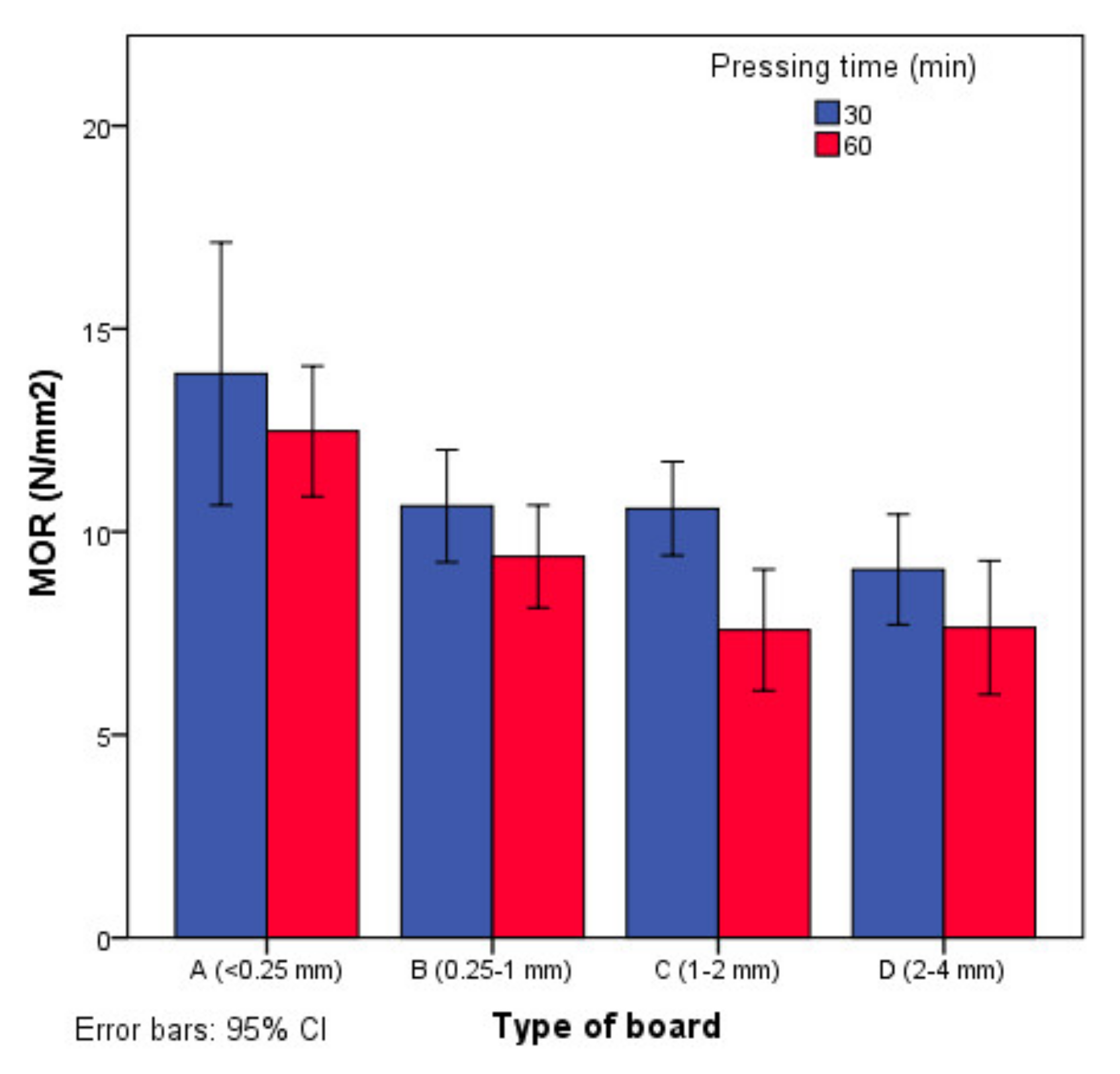
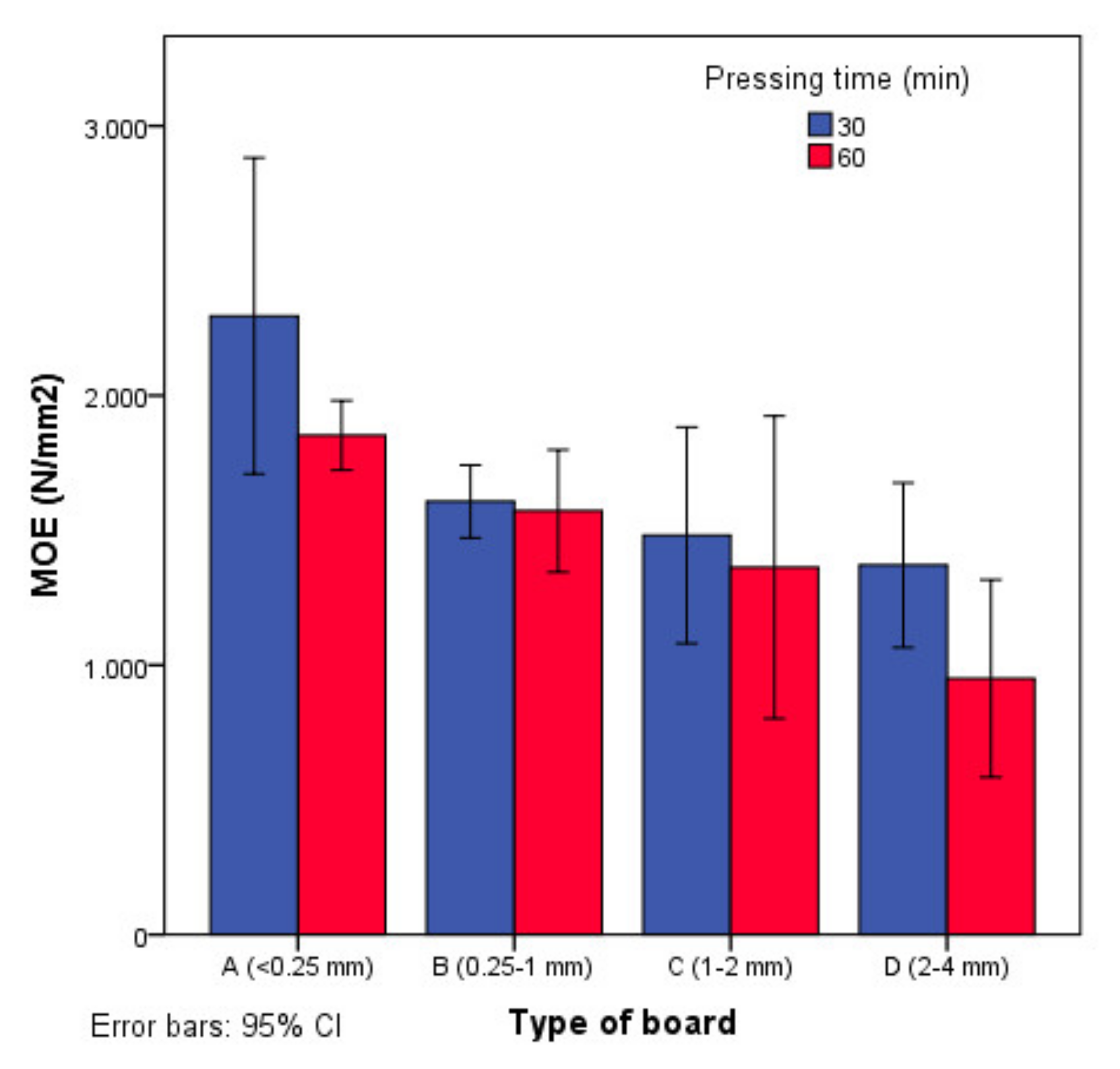
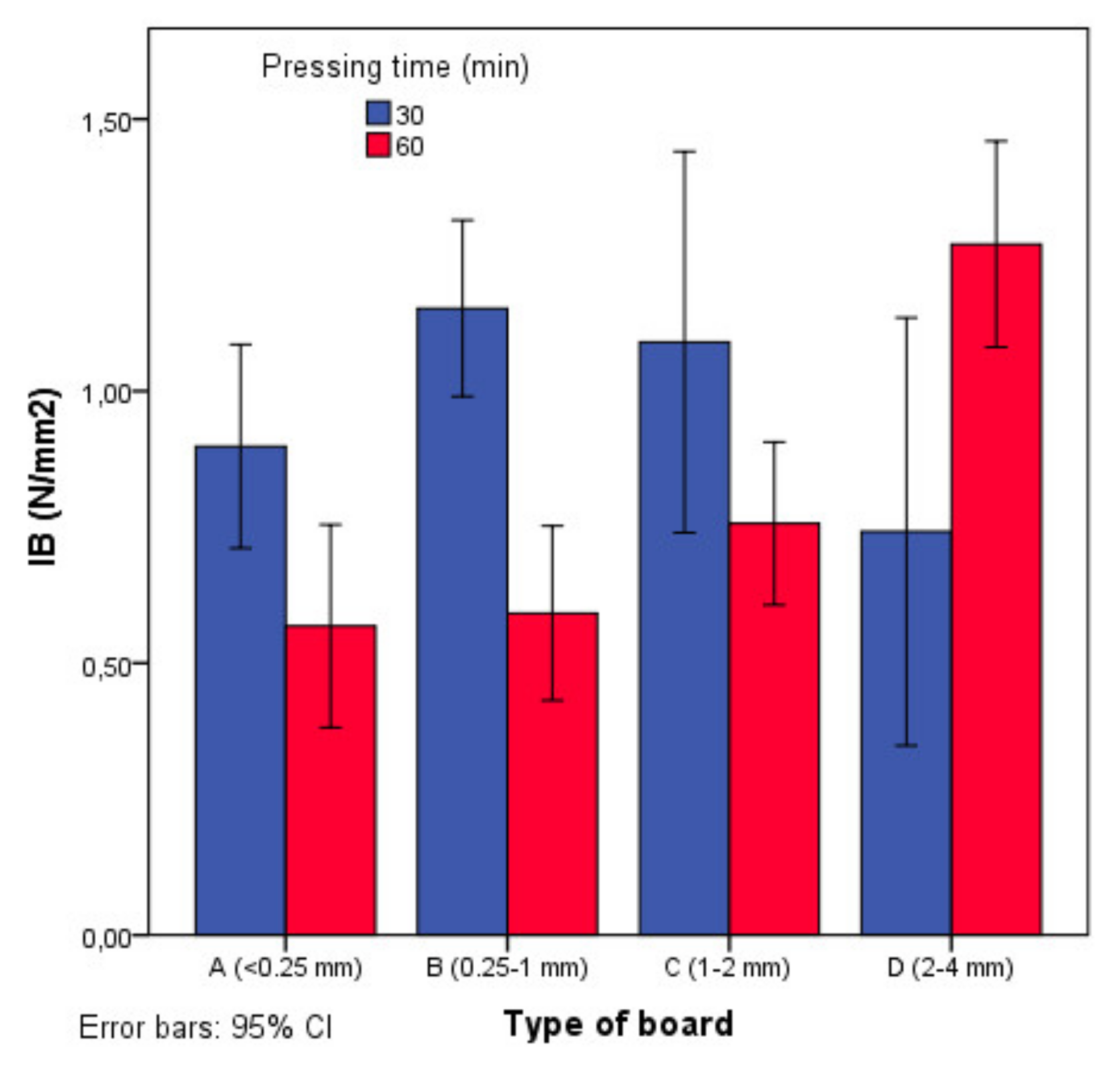
| Type of Board | No. of Boards | Particle Size (mm) | Time (min) | Pressure (Mpa) | Temperature (°C) |
|---|---|---|---|---|---|
| A1 | 6 | <0.25 | 30 | 2.5 | 120 |
| A2 | 6 | <0.25 | 30 + 30 = 60 | 2.5 | 120 |
| B1 | 6 | 0.25 to 1 | 30 | 2.5 | 120 |
| B2 | 6 | 0.25 to 1 | 30 + 30 = 60 | 2.5 | 120 |
| C1 | 6 | 1 to 2 | 30 | 2.5 | 120 |
| C2 | 6 | 1 to 2 | 30 + 30 = 60 | 2.5 | 120 |
| D1 | 6 | 2 to 4 | 30 | 2.5 | 120 |
| D2 | 6 | 2 to 4 | 30 + 30 = 60 | 2.5 | 120 |
| Type of Board | Pressing Time | TS 2 h (%) | TS 24 h (%) | WA 2 h (%) | WA 24 h |
|---|---|---|---|---|---|
| A1 | 30 | 11.11 (5.26) | 22.11 (7.74) | 11.66 (6.21) | 26.28 (8.18) |
| A2 | 30 + 30 | 9.10 (1.05) | 18.24 (3.94) | 12.11 (5.68) | 21.17 (7.37) |
| B1 | 30 | 13.54 (3.12) | 26.06 (4.02) | 13.09 (7.36) | 30.88 (8.21) |
| B2 | 30 + 30 | 16.35 (6.06) | 24.04 (1.84) | 20.42 (7.79) | 34.51 (9.68) |
| C1 | 30 | 8.77 (4.27) | 18.62 (7.29) | 6.83 (3.73) | 16.65 (6.22) |
| C2 | 30 + 30 | 10.24 (5.76) | 20.24 (9.48) | 20.16 (10.55) | 28.34 (7.93) |
| D1 | 30 | 9.62 (6.25) | 22.58 (9.12) | 8.24 (5.18) | 22.10 (10.79) |
| D2 | 30 + 30 | 17.51 (6.37) | 33.43 (7.06) | 18.18 (8.88) | 39.73 (10.04) |
| Factor | Properties | Sum of Squares | d.f. | Half Quadratic | F | Sig. |
|---|---|---|---|---|---|---|
| Particle size | TS 2 h (%) | 336.553 | 3 | 112.184 | 3.692 | 0.019 |
| TS 24 h (%) | 869.605 | 3 | 289.868 | 5.340 | 0.003 | |
| WA 2 h (%) | 238.837 | 3 | 79.612 | 1.031 | 0.388 | |
| WA 24 h (%) | 1403.742 | 3 | 467.914 | 3.616 | 0.020 | |
| MOR (N/mm2) | 220.893 | 3 | 73.661 | 19.123 | 0.000 | |
| MOE (N/mm2) | 6,164,529.410 | 3 | 2,054,843.137 | 12.550 | 0.000 | |
| IB (N/mm2) | 1.079 | 3 | 0.360 | 2.926 | 0.027 | |
| Pressing time | TS 2 h (%) | 109.232 | 1 | 109.232 | 3.210 | 0.080 |
| TS 24 h (%) | 76.860 | 1 | 76.860 | 1.111 | 0.297 | |
| WA 2 h (%) | 708.820 | 1 | 708.820 | 11.134 | 0.002 | |
| WA 24 h (%) | 699.873 | 1 | 699.873 | 5.032 | 0.030 | |
| MOR (N/mm2) | 31.065 | 1 | 31.065 | 3.732 | 0.045 | |
| MOE (N/mm2) | 877,907.085 | 1 | 877,907.085 | 4.021 | 0.039 | |
| IB (N/mm2) | 0.273 | 1 | 0.273 | 2.703 | 0.107 |
| Type of Board | MOR | MOE | IB | TS 24 h |
|---|---|---|---|---|
| A1 | 14.01 | 2295.32 | 0.90 | 22.11 |
| A2 | 12.48 | 1852.04 | 0.57 | 18.24 |
| B1 | 10.64 | 1606.83 | 1.15 | 26.06 |
| B2 | 9.39 | 1571.91 | 0.59 | 24.04 |
| C1 | 10.57 | 1481.50 | 1.09 | 18.62 |
| C2 | 7.58 | 1362.81 | 0.76 | 20.24 |
| D1 | 9.07 | 1370.56 | 0.74 | 22.58 |
| D2 | 7.64 | 950.65 | 1.27 | 33.43 |
| Type P1 [56] | 11.50 | - | 0.31 | - |
| Type P2 [56] | 12.00 | 1950.00 | 0.45 | - |
| Type P3 [56] | 14.00 | 1950.00 | 0.50 | 20.00 |
| Sugars | g/100 g | St. Dev. |
|---|---|---|
| Glucose | - | - |
| Xylose | 3.76 | 0.09 |
| Arabinose | 1.80 | 0.06 |
© 2019 by the authors. Licensee MDPI, Basel, Switzerland. This article is an open access article distributed under the terms and conditions of the Creative Commons Attribution (CC BY) license (http://creativecommons.org/licenses/by/4.0/).
Share and Cite
Ferrandez-Villena, M.; Ferrandez-Garcia, C.E.; Garcia Ortuño, T.; Ferrandez-Garcia, A.; Ferrandez-Garcia, M.T. Study of the Utilisation of Almond Residues for Low-Cost Panels. Agronomy 2019, 9, 811. https://doi.org/10.3390/agronomy9120811
Ferrandez-Villena M, Ferrandez-Garcia CE, Garcia Ortuño T, Ferrandez-Garcia A, Ferrandez-Garcia MT. Study of the Utilisation of Almond Residues for Low-Cost Panels. Agronomy. 2019; 9(12):811. https://doi.org/10.3390/agronomy9120811
Chicago/Turabian StyleFerrandez-Villena, Manuel, Clara Eugenia Ferrandez-Garcia, Teresa Garcia Ortuño, Antonio Ferrandez-Garcia, and Maria Teresa Ferrandez-Garcia. 2019. "Study of the Utilisation of Almond Residues for Low-Cost Panels" Agronomy 9, no. 12: 811. https://doi.org/10.3390/agronomy9120811
APA StyleFerrandez-Villena, M., Ferrandez-Garcia, C. E., Garcia Ortuño, T., Ferrandez-Garcia, A., & Ferrandez-Garcia, M. T. (2019). Study of the Utilisation of Almond Residues for Low-Cost Panels. Agronomy, 9(12), 811. https://doi.org/10.3390/agronomy9120811






